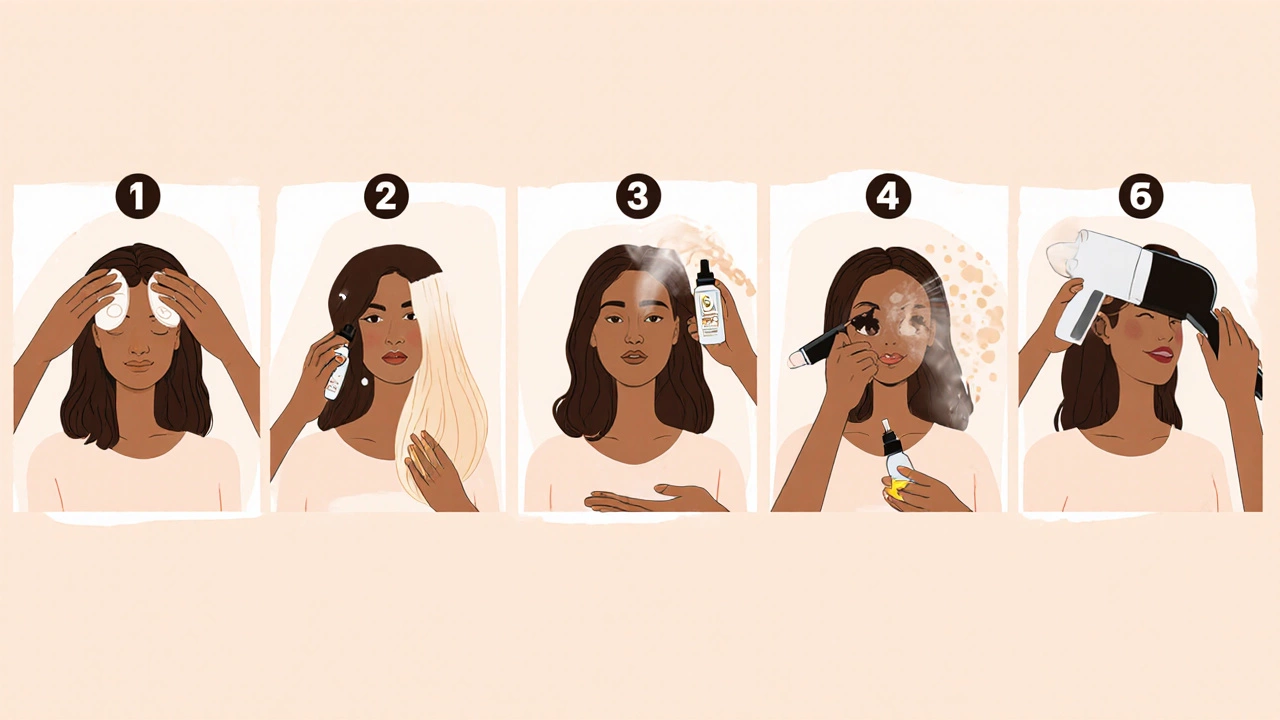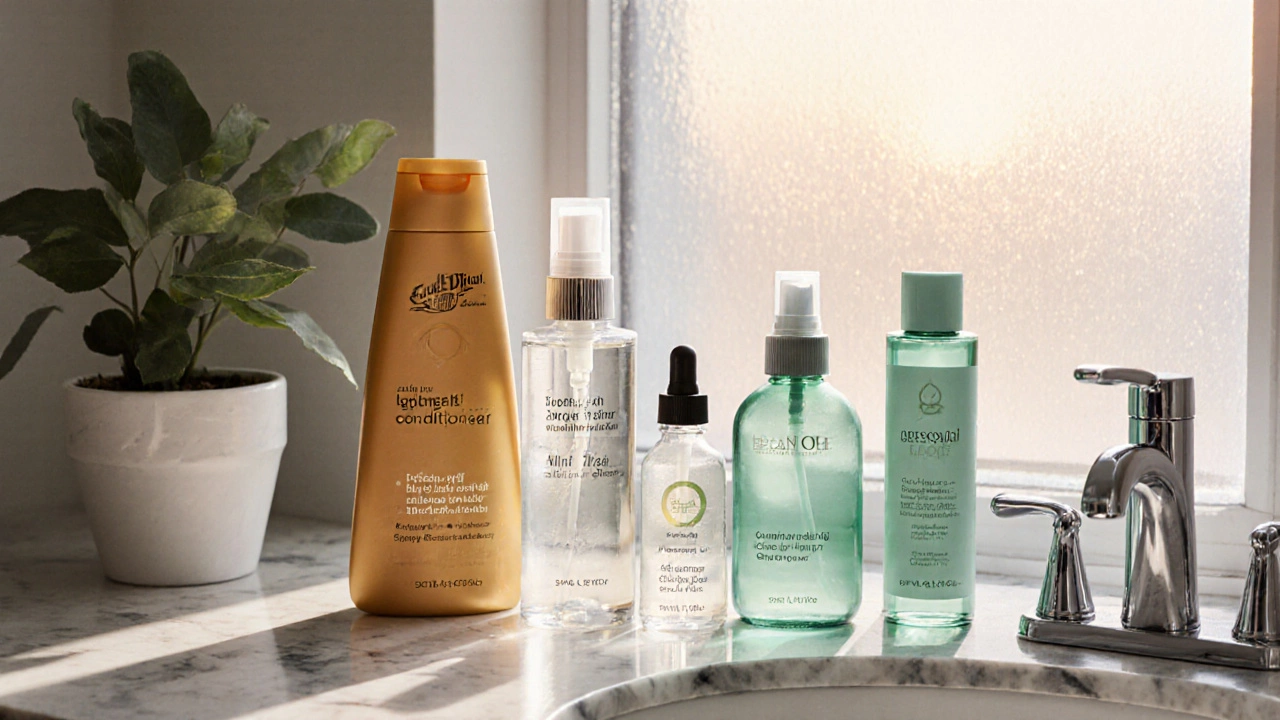Daily Hair Care Recommender
Get Your Personalized Daily Hair Care Routine
Select your hair type and goals to get recommendations for the products you should use every day.
Hair care product is a formulated item designed to cleanse, moisturize, protect, or style the hair on a daily basis. Choosing the right set helps you keep hair healthy, shiny, and manageable. If you’re wondering what should sit on your strands every morning, this guide walks you through the essentials, how to match them to your hair type, and which ingredients to steer clear of.
Why a Consistent daily hair care Routine Matters
Hair is exposed to heat, pollution, and weather changes day in, day out. A consistent routine does three things:
- Maintains the natural moisture balance, preventing brittleness.
- Creates a protective barrier against UV rays and styling heat.
- Supports scalp health, reducing itch and excess oil.
Skipping daily attention often leads to split ends, dullness, and a scalp that feels tight or greasy. The goal isn’t to pile on product-just the right ones, used in the right order.
Core Products You Should Use Every Day
Not every hair‑care item belongs in a daily lineup. Below are the seven staples most professionals recommend.
- Shampoo - a cleansing agent that removes dirt, oil, and product buildup without stripping essential lipids.
- Conditioner - a moisturizing rinse that smooths the cuticle and detangles.
- Leave-in conditioner - a lightweight, leave‑in formula that provides extra slip and light hydration throughout the day.
- Hair oil - usually a blend of plant‑based oils (argan, jojoba, or grapeseed) that seals moisture and adds shine.
- Heat protectant spray - a silicone‑based mist that forms a thermal barrier before blow‑drying or styling.
- Hair serum - a silicone or polymer‑rich liquid that smooths frizz and defines curl patterns.
- Scalp tonic - a lightweight, often menthol‑infused product that invigorates the scalp and balances oil production.
These products can be mixed and matched depending on your hair’s porosity, texture, and the styling tools you use.
Choosing the Right Products for Your Hair Type
Understanding your hair’s natural characteristics is the secret sauce. Here’s a quick guide:
- Fine, straight hair: Opt for lightweight conditioners and serums that won’t weigh strands down. A volumizing shampoo works best.
- Wavy or curly hair: Look for sulfate‑free shampoos, rich conditioners, and heavier oils (like coconut or castor) to lock in moisture.
- Coarse, textured hair: Choose a creamy leave‑in conditioner and a nourishing hair oil. A smoothing heat protectant is essential.
- Damaged or chemically treated hair: Prioritize protein‑infused shampoo, deep‑conditioner, and a reparative oil (e.g., argan). Limit heat protectant usage to when styling tools are truly needed.

How to Apply Products - The Perfect Order
Applying in the wrong sequence can cause product stacking, making hair feel greasy. Follow these steps each morning (or night, if you prefer washing before bed):
- Shampoo: Massage into wet scalp, focusing on the roots. Rinse thoroughly.
- Conditioner: Apply from mid‑lengths to ends, leave for 1-2 minutes, then rinse. If you have very dry ends, let it sit a little longer.
- Leave‑in conditioner: Spray or distribute a pea‑sized amount through damp hair, avoiding the scalp to prevent buildup.
- Hair oil: Warm a few drops between palms and smooth over the ends. For oily scalps, keep the oil away from the roots.
- Heat protectant spray: Mist evenly before using a blow dryer, flat iron, or curling wand.
- Hair serum: Apply a tiny amount to flyaways and any frizz‑prone spots after styling.
- Scalp tonic (optional): If you experience itch or excess oil, spray a light mist on the scalp and massage.
Stick to this order and you’ll notice smoother blow‑outs, less breakage, and a healthier feel overall.
Ingredient Watchlist: What to Avoid in Daily Products
Not all ingredients are created equal. Some can sabotage your hair’s natural balance when used every day.
| Ingredient | Why It’s Problematic | Better Alternatives |
|---|---|---|
| Sulfate (SLS, SLES) | Strips natural oils, leading to dryness | Sulphate‑free cleansers, mild surfactants |
| Silicone (dimethicone, cyclomethicone) | Can build up, weighing hair down | d>Silicone‑free serums, lightweight natural oils |
| Alcohol (denatured, SD alcohol) | Evaporates moisture, causing brittleness | Fatty alcohols like cetyl or stearyl alcohol |
| Parabens | Potential endocrine disruptors | Preservatives like phenoxyethanol |
Reading labels doesn’t have to be a nightmare. Look for “sulfate‑free,” “silicone‑free,” and “alcohol‑free” on the front of the bottle if you plan to use the product daily.
DIY & Natural Daily Boosters
If you love a hands‑on approach, these kitchen‑shelf items work wonders when mixed into your routine.
- Aloe vera gel: Light, cooling, and perfect under a leave‑in conditioner for a fresh scalp.
- Coconut oil: Ideal for thick, curly hair-apply a tiny amount to ends before styling.
- Green tea rinse: Antioxidant‑rich water that reduces scalp inflammation; use after shampooing.
- Apple cider vinegar (diluted 1:4): Restores pH balance and adds shine when used as a final rinse.
These natural options can replace commercial serums or tonics, but always patch‑test first.

Sample Daily Routines for Common Hair Goals
Pick the routine that matches your priority-volume, curl definition, or damage repair.
| Goal | Products | Key Steps |
|---|---|---|
| Volume & Lightness | Volumizing shampoo, lightweight conditioner, root‑lifting spray | Apply shampoo, rinse, condition ends only, spray root lift, style. |
| Frizz Control | Moisturizing shampoo, silicone‑free conditioner, anti‑frizz serum | Wash, apply conditioner, use a few drops of serum on damp hair, avoid heavy oils. |
| Curl Definition | Sulfate‑free shampoo, rich leave‑in conditioner, curl‑defining cream | Scrunch leave‑in, coil cream, diffuse lightly. |
| Damage Repair | Protein‑infused shampoo, deep‑conditioner (once a week), argan oil | Use deep conditioner nightly, finish with a few drops of oil. |
Adjust the frequency based on your schedule. For example, a deep‑conditioner can be reserved for weekends while the leave‑in stays daily.
Quick Daily Checklist
- Did I cleanse with a sulfate‑free shampoo?
- Did I condition only the mid‑lengths and ends?
- Did I apply a lightweight leave‑in or oil appropriate for my hair type?
- Did I protect my strands before using heat?
- Did I avoid products containing harsh alcohol or silicone?
Check this list each morning and you’ll stay on track without over‑thinking.
Frequently Asked Questions
Can I skip conditioner if I have oily scalp?
Yes. Use a lightweight conditioner only on the ends or switch to a rinse‑out conditioner that’s formulated for oily scalps. This keeps the roots from getting heavier while still providing moisture where it’s needed.
How often should I use a hair mask if I wash daily?
A deep‑conditioning mask once or twice a week is enough. Over‑masking can cause buildup, especially if the mask contains heavy oils.
Is silicone really bad for daily use?
Silicone creates a smooth coating that can feel great, but it doesn’t rinse out with water. Over time it builds up and can make hair feel limp. Opt for silicone‑free serums if you use products every day.
Should I apply hair oil before or after styling?
Apply oil after you’ve finished styling, focusing on the ends. This seals in moisture without interfering with heat protectants or causing greasy roots.
Can a scalp tonic replace shampoo?
No. A scalp tonic is a supplement that balances oil and soothes irritation. It works best after cleansing, not as a stand‑alone cleanser.

